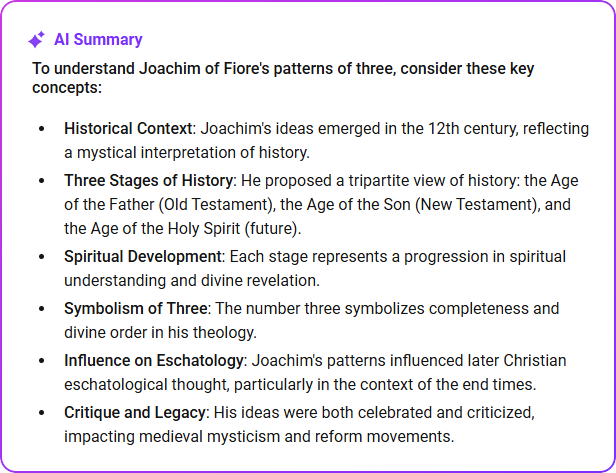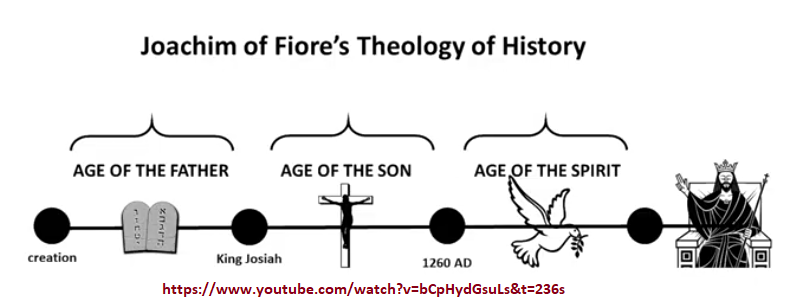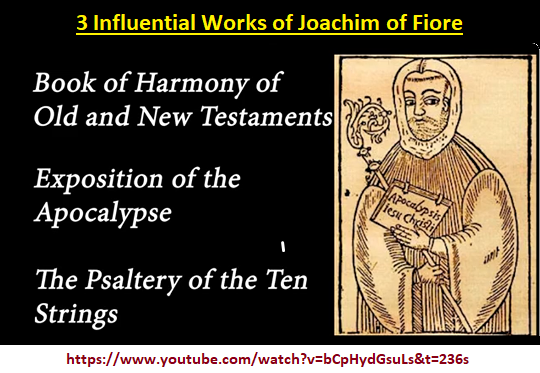Joachim of Fiore and his Threes:
Religious Threesologists as of Aug. 13th, 2025
Joachim of Fiore was an Italian theologian studying Christology and its associated metaphysics such as god, spirituality, and the end result of assiduous contemplation and application of one's beliefs. Multiple writers who came to focus on his works have mentioned his use of numbers such as 3, 4, and 7, though he was apparently adamant about not viewing the Trinity in terms of a 4-patterned (quaternion) construction. My interest at this time is to present an article found at the online Britannica whose writer uses the terms "pattern of two" and "pattern of three". Since I too have used such phrases and spoken of a developmental trend in consciousness, the underlying theme of Joachim's orientation appears to be very similar.
If you strip away the religious vocabulary/vernacular of his ideas and look at them in terms of an attempt to convey an explanation of cognitive activity, you will see parallels between his ideas and those that myself and others have been communicating. For those researchers like myself who are not oriented towards an application of enumerations in theological or Eastern philosophical contexts, it is of interest to note that we look at different contexts in which enumerations are taking place and apply them to our ongoing research interests, whatever they may be on an individual basis.
Again, let me emphasize that I am not reading the following Britannica article as a theological transcript. I look upon it as anyone would when encountering an ancient script and looking for repeating patterns as well as possible tell-tale signs commensurate in some value with current knowledge. Since I view all religions and Eastern Philosophies as if I have encountered runes on a stone erected during a time and place where the inhabitants were highly superstitious and did not themselves have the knowledge nor vocabulary to accurately interpret nor describe their perceptions created by the dispositions of their health and concerns for safety. In addition, those who have read ancient manuscripts and translated them can not be accepted as being totally accurate. Translations and translators can and do have errors... regardless of how many millions might believe in a given representation.
Note: instead of a religious theology, we might label it a religious threesology:

Joachim of Fiore (born c. 1130, /35, Celico, Kingdom of Naples [Italy]—died 1201/02, Fiore) was an Italian mystic, theologian, biblical commentator, philosopher of history, and founder of the monastic order of San Giovanni in Fiore. He developed a philosophy of history according to which history develops in three ages of increasing spirituality: the ages of the Father, the Son, and the Holy Spirit.

The known facts regarding the life of Joachim of Fiore are few. Legends about his parentage and youth are of little historical significance, but from an autobiographical reference it seems certain that he went on a pilgrimage to the Holy Land that reputedly had an effect on his conversion to the religious life. He became a Cistercian monk at Sambucina and in 1177 abbot of Corazzo (Sicily). About 1191 he broke away from the distracting duties of administration and retired into the mountains to follow the contemplative life. Although claimed as a fugitive by the Cistercians, Joachim was allowed by Pope Celestine III to form the disciples who gathered around him at San Giovanni in Fiore (a town located in present-day Cosenza province in Calabria) into the Order of San Giovanni in Fiore in 1196.
Far more significant is the evidence for the inner development of a man who came to believe that spiritual understanding would be given to one who wrestled with the "letter" of the Scriptures to get at the "spirit." Three moments of special illumination are indicated, but the first is only known in legendary form, connected with either his pilgrimage or his novitiate at Sambucina. The second, recorded by himself, took place one Easter eve, after a period of frustrated study of the biblical book of Revelation when he felt himself "imprisoned" by difficulties. In the midnight silence, suddenly his mind was flooded with clarity and his understanding released from prison. The third was an experience at Pentecost, when, after a time of agonizing doubt on the doctrine of the Trinity, Joachim had a vision of a psaltery with 10 strings, in a triangular form, that clarified the mystery through a visual symbol and called forth paeans of praise from him. He expresses this experience of illumination given after mental striving in terms of the city seen intermittently by the approaching pilgrim or of the spirit breaking through the hard rind of the letter.
He was summoned by Pope Lucius III in 1184 and urged to press on with the biblical exegesis he had begun. This probably refers to the Liber concordie Novi ac Veteris Testamenti ("Book of Harmony of the New and Old Testaments"), in which Joachim worked out his philosophy of history, primarily in a pattern of "twos"—the concords between the two great dispensations (or Testaments) of history, the Old and the New. But already Joachim's spiritual experience was creating in his mind his truly original "pattern of threes." If the spiritualis intellectus springs from the letter of the Old and New Testaments, then history itself must culminate in a final age of the spirit that proceeds from both the previous ages. Thus was born his trinitarian philosophy of history in which the three Persons are, as it were, built into the time structure in the three ages or status of the Father, Son, and Holy Spirit.

The third status was to be won by the church only after arduous pilgrimage and great tribulation, like the Israelites marching through the wilderness and crossing the Jordan River into the Promised Land. As guides through this crucial stage, Joachim prophesied the advent of two new orders of spiritual men, one of hermits to agonize for the world on the mountaintop and one a mediating order to lead men on to the new spiritual plane. Although the third age belongs par excellence to contemplatives, secular clergy and laymen are not shut out of it. In a strange diagram, a "ground plan" of the New Jerusalem, various categories of monks are grouped around the seat of God, but below, secular clergy and tertiaries (lay members) live according to their rule.
In the Expositio in Apocalypsim ("Exposition of the Apocalypse"), Joachim seeks to probe the imminent crisis of evil, as pictured in the apocalyptic symbols of Antichrist, and the life of the spirit to follow. His third main work, the Psalterium decem chordarum ("Psaltery of Ten Strings"), expounds his doctrine of the Trinity through the symbol of his vision of the 10-stringed psaltery. Here and in a lost tract he attacked the doctrine of "quaternity" (an overemphasis on the "one essence" of the Godhead that seems to separate it from the three Persons of the Trinity and so create a fourth), which he attributed to Peter Lombard, a 12th-century theologian. Besides this trilogy, written concurrently, Joachim left minor tracts and one uncompleted major work, the Tractatus super quattuor Evangelia ("Treatise on the Four Gospels").
Joachim was a poet and artist. His lyricism breaks through the biblical exegesis that he chose as his medium and the turgid Latin of his style. Above all, his visual imagination is expressed in the unique Liber figurarum ("Book of Figures"; discovered in 1937), a book of drawings and figures thought to be a genuine work by most Joachim scholars today. Here his vision of the culminating age of history is embodied in trees that flower and bear fruit luxuriantly at the top; his doctrine of the Trinity is expressed in remarkable geometric figures; his kaleidoscopic vision fuses images in some strange shapes, such as the tree that becomes an eagle, which may have influenced Dante. Joachim’s figures probably carried his ideas in exciting and popular form far more widely than his indigestible writings.
In his lifetime Joachim was acclaimed as a prophet, gifted with divine illumination, and this is how he was seen by the first chroniclers after his death. The condemnation of his tract against Peter Lombard by the fourth Lateran Council in 1215 dimmed his reputation for a time, but the appearance of the Franciscan and Dominican mendicant orders, hailed as Joachim’s new spiritual men, reestablished him as a prophet. The Spiritual Franciscans at mid-13th century and various other friars, monks, and sects down to the 16th century appropriated his prophecy of a third age. But Joachim has always had a double reputation, as saint and as heretic, for cautious Christian thinkers and leaders have seen his writings as highly dangerous. The debate as to whether he was orthodox or heretic continues today.
The proposed "doctrine of "quaternity" which essentially describes "one essence" of the Godhead that seems to separate it from the three Persons of the Trinity", which Joachim was against can be viewed as a 3 to 1 ratio. It is a topic of consideration that did not exist in his time and the conceptual relevance is not known by many today.
Western Religions have perspectives which are childishly easy to comprehend, but are intentionally made to appear as complex philosophies with as yet undiscovered unique depths of wisdom, insight and vast galaxies of unexplored knowledge, by those involved in this type of intellectual enterprising:
- Christianity, with its multiple types.
- Islam can be viewed as a western religion when and where its doctrine is influenced by such.
- Judaism, with its multiple types.
Likewise all brands and models of Eastern philosophy are similarly childish in their contoured explanations of reality and humanity's place/participation in it:
- Buddhism - Buddhism is broadly divided into three main branches: Theravada, Mahayana, and Vajrayana.
- Hinduism - Hinduism encompasses four primary denominations: Vaishnavism, Shaivism, Shaktism, and Smartism.
- Islam (when influenced by Eastern Philosophy)- The main branches of Islam are Sunni and Shia. Other groups are Sufis, Ahmadiyya, and Ibadi Muslims.
- Jainism - Jainism is primarily divided into two major sects: Digambara and Svetambara. These sects share core beliefs but differ in their practices and interpretations of Jain scriptures. Both sects also have further subdivisions.
- Sikhism - Sikhism encompasses various sects and groups, with the most prominent being the Khalsa, Udasi, Nirmala, and Namdhari. While not always considered separate denominations, divisions exist based on adherence to specific traditions, interpretations, and practices within Sikhism.
- Taosim (Daoism) - Taoism, also known as Daoism, encompasses both philosophical and religious traditions. Philosophical Taoism, exemplified by texts like the Tao Te Ching and Zhuangzi, focuses on the principles of the Tao and living in harmony with nature. Religious Taoism, on the other hand, involves organized practices, rituals, and a clergy, with major branches like Zhengyi (Orthodox Unity) and Quanzhen (Complete Perfection).
The different religions and philosophies represent different ways of expressing fundamental cognitive activity just as the overall biology of humanity is but one type of expression amongst multiple other kinds, but a comparative analysis shows us that there are similarities. While numbers themselves are an expressed quality, all qualities, enumerated or otherwise, can be measured by different models of comparison. Whereas I preference the number 3, others prefer some other number such as 1, 2, 4, 5, 6, 7, 8, 9, 10, 11, 12, 13, or otherwise. If we were on the 18th planet from the Sun, I would consider the value of 18 valuable. Similarly, if there were 18 fundamental atomic particles instead of three, I would say that this idea enforces the value of 18. Likewise if we had 18 instead of 3 Germ layers and an 18 DNA code instead of 3.
While some might argue that Joachim's interest was influenced by the idea of the Trinity, what if Religion was merely the medium which afforded him the best opportunity to reference an underlying cognitive disposition to relate to the world in threes? Likewise for those philosophers (musicians, etc...) throughout history that have exhibited a penchant for using a formulaic recurrence of some "three" model, and expressed with the vernacular of the subject and age and culture they were living in.. and permitted an exercise for using a "three" orientation where some other subject or day to day activity does not allow for it because there might be some other dominant pattern being practiced by the "overseers" of a given lifestyle.
Different jobs, just like different classrooms where specific topics are being discussed and practiced as particularized thinking; a person can find religion and philosophy are friendlier places for a person to be respected who is oriented towards "threes". Involving oneself in Astrology, Palmistry, or some occult-like perspective denoted as a fringe practice, is a calling card to being viewed as someone practicing a dead-ended model of Numerology, like so much of Mathematics is being practised. And though someone interested in a given subject may shoehorn the topic of "three" into a conversation such as talking about 3-point shots in basketball, or triplets in a maternity ward, or some rock- scissors- betting scheme to settle an argument, or as a topic in cultural anthropology, having a penchant for threes or any number, or penchant for music, or penchant for antiques, etc., requires a given environment for expression.
We see this in biology where the practice of a triplet code is expressed in different models called different life forms or species. The triplet code is being expressed in different models according to the environment most suitable... even when a species tries to explore outside a comfort zone or that which is best suited for their specific contour of design. Whatever the recurrence of "three" may mean in human cognitive terms, despite all the repeated nonsense being pushed onto the public by serial psychology blogs speaking about memory as well as other topics of consideration:

It is particularly ironic and hypocritical for so many people stressing the value of using threes, and yet it is not taught as a valued subject and instead, we find that both Psychology and Mathematics are based on a recurring Persistence of Dualities.
Page initially created: Wednesday, August 13th, 2025...8:53 AM
Initial posting: Wednesday, August 13th, 2025... 2:14 PM